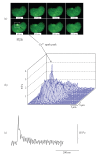Role of ryanodine receptor subtypes in initiation and formation of calcium sparks in arterial smooth muscle: comparison with striated muscle
- PMID: 20029633
- PMCID: PMC2793424
- DOI: 10.1155/2009/135249
Role of ryanodine receptor subtypes in initiation and formation of calcium sparks in arterial smooth muscle: comparison with striated muscle
Abstract
Calcium sparks represent local, rapid, and transient calcium release events from a cluster of ryanodine receptors (RyRs) in the sarcoplasmic reticulum. In arterial smooth muscle cells (SMCs), calcium sparks activate calcium-dependent potassium channels causing decrease in the global intracellular [Ca2+] and oppose vasoconstriction. This is in contrast to cardiac and skeletal muscle, where spatial and temporal summation of calcium sparks leads to global increases in intracellular [Ca2+] and myocyte contraction. We summarize the present data on local RyR calcium signaling in arterial SMCs in comparison to striated muscle and muscle-specific differences in coupling between L-type calcium channels and RyRs. Accordingly, arterial SMC Ca(v)1.2 L-type channels regulate intracellular calcium stores content, which in turn modulates calcium efflux though RyRs. Downregulation of RyR2 up to a certain degree is compensated by increased SR calcium content to normalize calcium sparks. This indirect coupling between Ca(v)1.2 and RyR in arterial SMCs is opposite to striated muscle, where triggering of calcium sparks is controlled by rapid and direct cross-talk between Ca(v)1.1/Ca(v)1.2 L-type channels and RyRs. We discuss the role of RyR isoforms in initiation and formation of calcium sparks in SMCs and their possible molecular binding partners and regulators, which differ compared to striated muscle.
Figures




Similar articles
-
Elementary calcium signaling in arterial smooth muscle.Channels (Austin). 2019 Dec;13(1):505-519. doi: 10.1080/19336950.2019.1688910. Channels (Austin). 2019. PMID: 31797713 Free PMC article. Review.
-
Ca2+ channels, Ca2+ sparks, and regulation of arterial smooth muscle function.Z Kardiol. 2000;89 Suppl 2:15-9. doi: 10.1007/s003920070095. Z Kardiol. 2000. PMID: 10769399 Review.
-
Ontogeny of local sarcoplasmic reticulum Ca2+ signals in cerebral arteries: Ca2+ sparks as elementary physiological events.Circ Res. 1998 Nov 30;83(11):1104-14. doi: 10.1161/01.res.83.11.1104. Circ Res. 1998. PMID: 9831705
-
Calcium sparks in human coronary artery smooth muscle cells resolved by confocal imaging.J Hypertens. 2000 Sep;18(9):1215-22. doi: 10.1097/00004872-200018090-00007. J Hypertens. 2000. PMID: 10994752
-
Regulation of calcium sparks and spontaneous transient outward currents by RyR3 in arterial vascular smooth muscle cells.Circ Res. 2001 Nov 23;89(11):1051-7. doi: 10.1161/hh2301.100250. Circ Res. 2001. PMID: 11717163
Cited by
-
Skeletal Muscle Transcriptome Analysis of Hanzhong Ma Duck at Different Growth Stages Using RNA-Seq.Biomolecules. 2021 Feb 19;11(2):315. doi: 10.3390/biom11020315. Biomolecules. 2021. PMID: 33669581 Free PMC article.
-
Mechanisms of Acute Alcohol Intoxication-Induced Modulation of Cyclic Mobilization of [Ca²⁺] in Rat Mesenteric Lymphatic Vessels.Lymphat Res Biol. 2015 Jun;13(2):93-9. doi: 10.1089/lrb.2014.0048. Epub 2015 Jun 9. Lymphat Res Biol. 2015. PMID: 26056854 Free PMC article.
-
Heart failure in diabetes.Metabolism. 2021 Dec;125:154910. doi: 10.1016/j.metabol.2021.154910. Epub 2021 Oct 8. Metabolism. 2021. PMID: 34627874 Free PMC article. Review.
-
Calcium-activated potassium channels in ischemia reperfusion: a brief update.Front Physiol. 2014 Oct 6;5:381. doi: 10.3389/fphys.2014.00381. eCollection 2014. Front Physiol. 2014. PMID: 25339909 Free PMC article. Review.
-
Calcium signals that determine vascular resistance.Wiley Interdiscip Rev Syst Biol Med. 2019 Sep;11(5):e1448. doi: 10.1002/wsbm.1448. Epub 2019 Mar 18. Wiley Interdiscip Rev Syst Biol Med. 2019. PMID: 30884210 Free PMC article. Review.
References
-
- Cheng H, Lederer WJ. Calcium sparks. Physiological Reviews. 2008;88(4):1491–1545. - PubMed
-
- Nelson MT, Cheng H, Rubart M, et al. Relaxation of arterial smooth muscle by calcium sparks. Science. 1995;270(5236):633–637. - PubMed
-
- Ledoux J, Werner ME, Brayden JE, Nelson MT. Calcium-activated potassium channels and the regulation of vascular tone. Physiology. 2006;21(1):69–79. - PubMed
Publication types
MeSH terms
Substances
LinkOut - more resources
Full Text Sources
Research Materials
Miscellaneous

